Recently I had a question about the Kenko teleconverter about if it functions with SDM lenses and if the teleconverter hurts image quality. I thought this was a good request and warranted an article or two on the blog.
If you are not familiar with teleconverters (TC for short), they attach between the camera and lens allowing you more reach, or rather more magnification. Some people feel they are not necessary and hurt image quality, but I personally feel they can be of use and some of the available teleconverters don’t cause large drops in image quality.
Here is the Kenko teleconverter sandwiched between a DA* 300mm lens and K10D camera body:
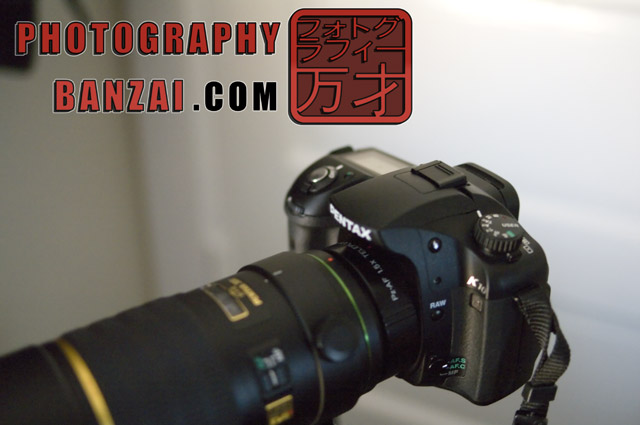
Pentax does not have any teleconverters available in the USA for sale, but private sellers at places like the pentaxforums.com marketplace have a few options available. The Kenko Pz-AF 1.5x Teleplus SHQ is an older teleconverter that is still available in Japan that is available here through those secondary methods. The interesting thing about this teleconverter is that it passes through the two “power zoom” contacts, which Pentax re-purposed for use as SDM autofocus contacts. This allows the lenses with drive motors inside to function fully. A negative would be that the camera body does not see a corrected focal length, so shake reduction might be less effective than normal.
Here is the teleconverter in detail:
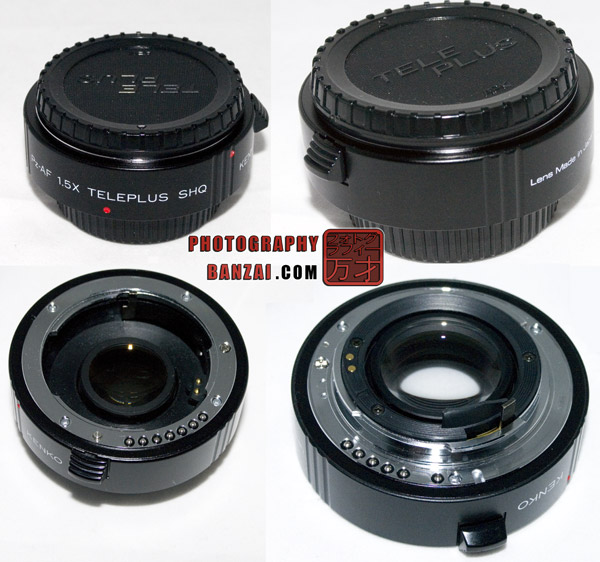
Even though it can’t be bought directly from a store in the USA, it’s still one of the cheaper options available. Surprisingly, it’s also said to be pretty good optically. I’ve used it quite a bit and agree with that statement.
I decided to setup a little test to give people an idea of how the teleconverter works and what it can do. My test consisted of taking pictures with a K10D camera body, DA* 300mm F4 SDM lens, and the Kenko teleconverter. I took photos of a testing chart that I had printed on a laser printer with standard 8.5×11 paper, which was mounted on a wall around 10 feet from the camera and tripod. I decided to not move the tripod between tests, so you could get a feel for the level of magnification 1.5x provides on the 300mm lens. The camera was placed in manual focus mode as I took photos at 4 select apertures. I adjusted the shutter speed by hand and had the ISO at 100. The room was pretty dark, with most of the light shinning on the subject from below.
Here is a picture of the two frames (with and without TC) at a single aperture:
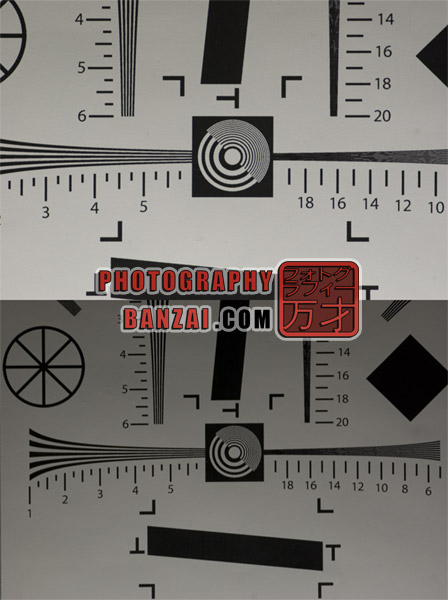
The first image (top) is with the teleconverter, and the second is without. When I adjusted the shutter speed, the light meter tended toward over-exposure with the TC and underexposure without. All 4 tests were the same way (eg. at each aperture setting).
Processing the test images consisted of opening them in Photoshop CS2, selecting auto-adjust in camera raw to level out exposure and then running a custom action I had made which takes a 600×600 full sized section of the middle of each image and then also takes 100×100 pieces the edges of the image as samples to display corner sharpness.
Here are the 4 tests (apertures F4, F5.6, F11, and F22):
(click on each to see the full sized version.)
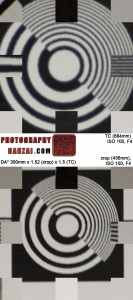 |
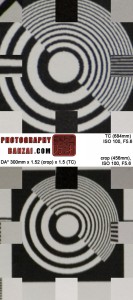 |
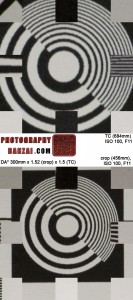 |
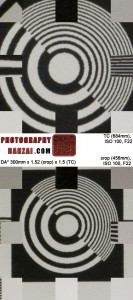 |
I’d say using the teleconverter allows for an actual improvement in optical resolving ability from that 1.5x multiplier, especially at wider apertures. The Kenko does not obviously show a decrease in sharpness to my eyes as many teleconverters are said to do, but I do think there are more aberrations when it is being used. It’s tough to say if enlarging an image in post processing would result in lesser quality at smaller apertures.
Chromatic aberrations:

The teleconverter image shows a thicker band of aberrations, bit It’s possible it partly came from more zooming ability. However, I think it is due to having that extra piece of glass in the imaging pipeline.
Auto-focusing with the teleconverter on an SDM lens:
I took a video with my K-7 of the K10D focusing with and without the teleconverter.
It is showing the Kenko teleconverter work with the Pentax camera SDM auto focus.
It was pretty dark and the position to the subject was not changed. The camera without the TC attached seemed a bit odd as I had to half-press a few times for the camera to gain absolute focus except for one time when it went directly to the focus position. That was probably just a fluke, so I’d say in general the teleconverter makes focusing a bit slower. I usually use the setup with my K-7 instead, which is faster overall as well.
I’m pretty impressed with the quality and functionality of this teleconverter considering it was relatively cheap compared to other options that are available like the Pentax 1.7x autofocus adapter. I have not noticed any visual decrease and the autofocus with my SDM lens is serviceable. I even went as far as to have a custom bracket for my bushhawk camera mount made that was designed for use with the teleconverter and DA* 300mm.
